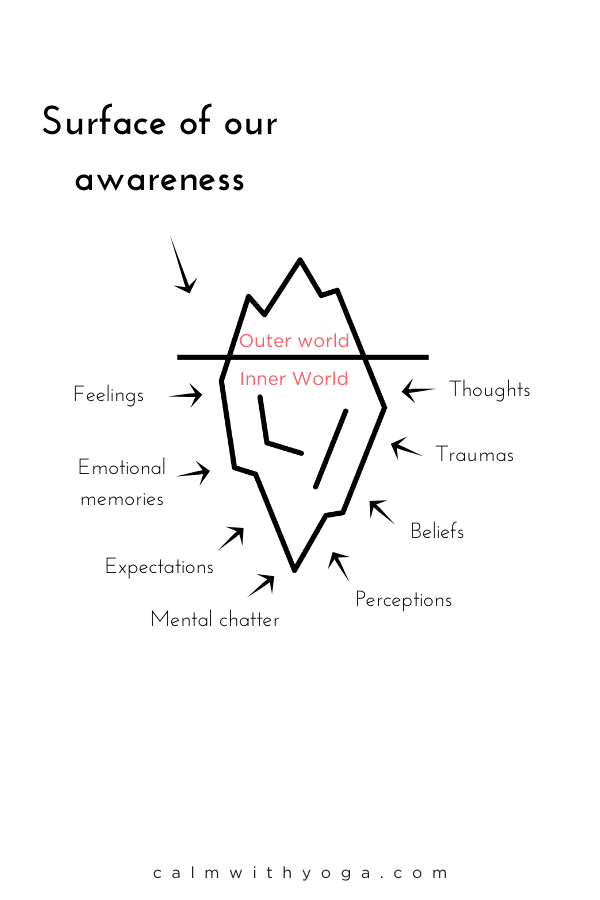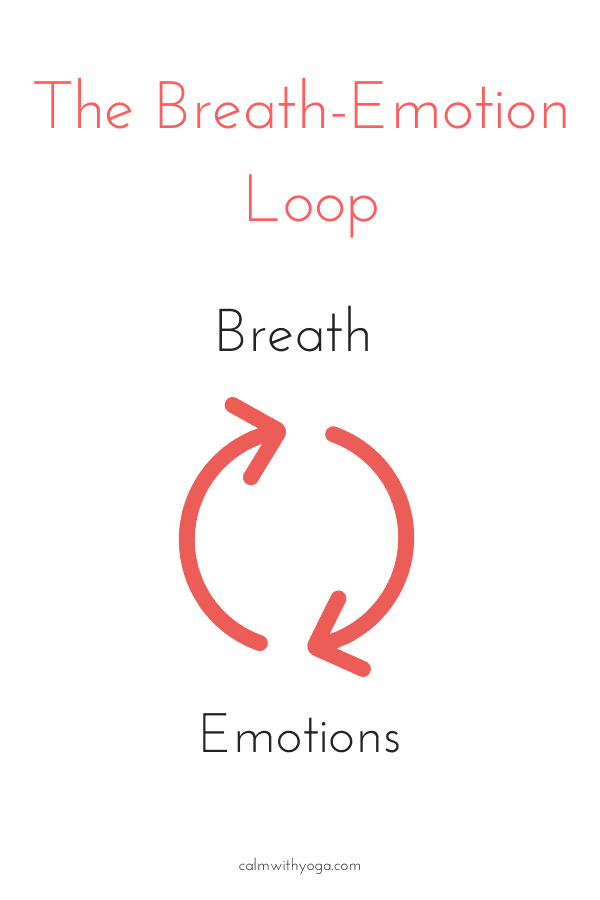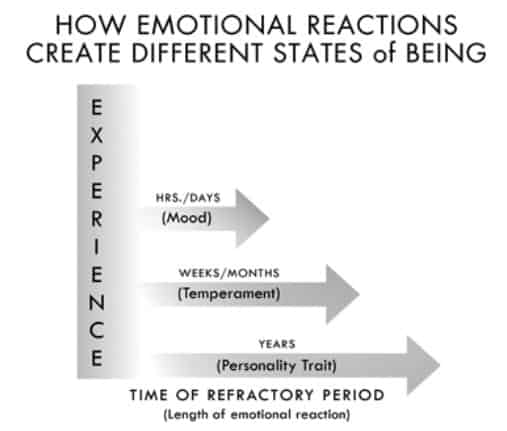Is it true? Can you absolutely know it’s true? Don’t allow your mind to be infested with negative thoughts. -Dr. Daniel Amen, author of “Change Your Brain, Change Your Life” No one escapes them. Bad moods are neither good nor bad things per se. (Neither are good moods, by the way.) Sure, they’re not fun to experience and can often derail our entire day or even days. They can be frustrating and draining on our energy and mental health. Who doesn’t know what it’s like to feel hijacked by a negative mood you can’t quite shake off or get over? You have a fight with your partner. PMS shows her ugly head. Pregnancy hormones have you in a tizzy. Or maybe your kids are fighting non-stop and you can’t even make a ten-minute dinner without having to break it up. It can often feel as if you’re at the mercy of your emotional responses and automatic negative thoughts; as if they control you and there’s nothing you can do about it. But you actually have more power than you think during those moments. There are specific simple things you can do to create a positive effect in the face of overpowering negative emotions. “Bad” moods can be informative and transformative if you’re willing to shift your perspective a bit… Moodiness provides us with two things:
1 – Feedback about what’s going on in our internal world.
Our inner world is comprised of our thoughts, emotional memories, feelings, beliefs, perceptions, and expectations. Moodiness is a symptom of what’s going on underneath the surface of our awareness, and so if we dig deeper we can use it as feedback. Mood swings are like the tip of the iceberg of our inner world and we can use them to uncover areas we need to pay attention to or work on.
2 – Growth opportunity.
Each unpleasant, confronting, or uncomfortable moment offers us an opportunity to grow beyond our current limiting perceptions and ways of being… if we choose to accept the offer. The shell cracks, its insides come out and everything changes. To someone who doesn’t understand growth, it would look like complete destruction. – Cynthia Ocelli, author It’s not easy though. It’s not easy facing that which brings us discomfort and owning parts of us we’re not particularly fond or proud of. But according to yogic wisdom, being able to withstand the heat of discomfort is a prerequisite for achieving mental and emotional mastery.
Using the Yogic Principle of Tapas to Manage Moods:
By practicing the yogic principle of Tapaswe train the mind and body to be able to endure discomfort. Anything burned out will be purified… But how can this burning process be effected with our mental impurities? By accepting all the pain that comes to us, even though the nature of the mind is to run after pleasure. We will actually be happy to receive pain if we keep in mind its purifying effects. – Swami Satchidananda, yogic teacher & translator/ commentator of the Yoga Sutras of Patanjali This is an empowering exercise that trains us to become familiar with our inner world so we can become more adept and confident at transforming moods and emotional reactions. We practice Tapas by staying present with the emotion, reaction, or mood. We stay present even when we want to distract or run away. You may have already been exposed to this principle on the mat and in asana practice – the physical aspect of yoga. Physically you can practice Tapas by staying with the challenge and discomfort that comes from bodily sensations in the postures. Another added benefit of practicing Tapas on the mat is the release of endorphins that follows intense physical activity – this will also keep moods in check. 🙂 The following 4-step process will help you practice Tapas…
4-Step Mood-Shifting Process:
Here’s what to do the next time your mood takes a dive: Conscious breathing is my anchor. – Thich Nhat Hanh, Buddhist monk & author
Step #1–Becoming aware of your breath.
Cultivating the habit of daily breath awareness is so effective at stilling the ripples of the mind that even Buddha himself taught this practice to monks. In particular, the Buddhist Anapanasati Sutta, also known as the “Discourse on the Full Awareness of Breathing,” details Buddha’s instructions on how to use the breath to cultivate calm focus and mindfulness (aka Anapana breathing): “Breathing in, I know I am breathing in. Breathing out, I know I am breathing out. Breathing in, I am aware of my whole body. Breathing out, I am aware of my whole body. Breathing in, I calm my whole body. Breathing out, I calm my whole body” Mindfully paying attention to our breath means noticing and observing it without judging it and without having the need to change it in any way. Just noticing the inhales and exhales. Taking mindful deep breaths… Bringing full awareness to the sensation and feeling of the breath coming into the nostrils and coming out of the nostrils. If a thought comes, (which it will, especially if you’re in a mood!) simply bring your attention back to the breath. Want more guidance? Follow along with us here.
Step #2–Consciously control the breath.
Yogic sages have known for thousands of years that the breath is the portal through which we can transform mental/emotional tension while accessing a state of inner calm and grounded balance. Your breathing pattern alone can tell you so much about your internal world. But when the breath is calmed the mind too will be still, and the yogi achieves long life. – The Hatha Yoga Pradipika, a 500-year-old authoritative yogic text This is because your breathing pattern is intimately tied to your mood. Influence one, and you also impact the other. They form what’s called the Breath-Emotion Loop:
1- Our emotions, thoughts, and moods influence our breathing patterns. Next time you’re in a mood pay attention to your breathing pattern. You’ll probably notice it’s short, shallow, erratic and/or quick. Then notice your breathing next time you feel calm, safe, deep in concentration, or at ease. Notice it’ll probably be slower, longer, even-paced, and/or deeper. 2- Our breathing patterns can influence our mood. If you were to start breathing rapidly taking short and shallow breaths you’ll likely start feeling either awake and alert, or anxious and on guard. And so, if you begin breathing slowly and deeply you will most probably begin to feel less uneasy and more relaxed. Paying attention to our breathing patterns can tell us a lot about our mood. Often times we’re not even aware we’re in a mood until something or someone on the outside reflects it back to us and it’s only then that we realize. We can become more still and present by consciously controlling our inhales and exhales, and that’s how awareness is born. This is also considered the Yoga of Emotions. This is a mental yoga practice (sadhana).
Step #3–Acknowledge what’s there.
Once you’ve spent some time consciously breathing and regulating your inhales and exhales for at least 5 minutes, you’ve likely started a cascade of bodily reactions such as activating your nervous system’s relaxation response. it’s also practiced with the breath and with awareness. Controlled deep breathing has the power to help us calm down. It’s in this calmer state that we have access to higher brain centers that can help us shift emotionally. Getting present with what we’re feeling and then labeling it out loud may actually have a therapeutic effect on the brain, further strengthening our capacity for emotional control. According to one UCLA brain scan study, the mere act of naming or labeling our emotions has the power to deactivate the brain’s amygdala, known as the emotional /stress center, while activating or vamping up our brain’s higher thinking centers that help with emotional processing.(1) So the next time you’re in the throes of your moodiness:
- Watch your breath. Follow it.
- Consciously control your breath.
- Be gentle with yourself. Treating yourself gently will send safety signals to your mind and body. We need to feel safe in order to tap into what we’re really feeling. Only then can we acknowledge what we feel. Expressing feelings and emotions in the moment can be healing and transformative. It can also be a practice in self-care, which cultivates self-esteem.
Step #4 – Release the need to overcome it…Lessen the resistance.
Once you’ve pinpointed what’s there let go of the need or desire to overcome it, change it, eradicate it, or avoid it. Use your breath to guide you as you practice Tapas and sit with it, just as it is. Mindfully paying attention to what’s there means noticing and observing it without judging it and without having the need to change it in any way. Just noticing. This is not an exercise for perfection, it is an exercise for mastery. Each time you catch yourself holding onto judgment about your mood, your emotions, or the situation simply release it a little bit more. This will be a game of touch-and-go. This will be an ebb and flow between attachment and judgment… and then release… Attachment and judgment… And release. And on it goes… According to neuroscientist and author Dr. Joe Dispenza, a mood is an emotional reaction that lasts from hours to days. If we don’t effectively manage our mood it will last longer than that and can eventually turn into a more permanent fixture of our personality. This is why it’s a good idea to get really good at becoming aware of and managing our moods better. Remember, each mood swing or bad day is an opportunity for growth and further self-connection. We can turn our mood around, and this starts with our breath… If we regain control of our breathing we can regain control of our mood. Here’s a 1-minute session to help get you started: REFERENCES : (1)http://newsroom.ucla.edu/releases/Putting-Feelings-Into-Words-Produces-8047




title: “Get Out Of A Bad Mood Quickly With This Process Motherhood Community” ShowToc: true date: “2022-11-30” author: “Amanda Eanes”
– Ralph Waldo Emerson, filósofo y escritor Nadie les escapa. Los malos estados de ánimo no son ni “malos” ni “buenos”. Claro, no son divertidos de experimentar y con frecuencia pueden descarrilar todo nuestro día o incluso días. Pueden ser frustrantes y agotadores. Quién no sabe lo que es sentirse atrapada por un estado de ánimo que no puedes deshacer o superar. Es como si estuvieras a merced de tus emociones y pensamientos; como si te controlaran y no hay nada que puedas hacer al respecto. Pero en realidad tienes más poder del que crees en esos momentos. Si crees que el buen humor es difícil de lograr, estás en un error. Los malhumorados, aquellos con mal genio, también tienen puntos débiles. Enojarse no es saludable y tu mal temperamento puede ser perjudicial. Por eso, la actividad física, el aire fresco, y otras técnicas logran una mejor manera de afrontar los obstáculos y alcanzar una vida saludable. He aquí el por qué de tu poder: Los “malos” estados de ánimo pueden ser informativos y transformadores si estás dispuesta a cambiar un poco tu perspectiva. Los cambios de humor nos proporciona dos cosas: 1 – Feedback sobre lo que está pasando en nuestro mundo interno.
Nuestro mundo interior está compuesto por nuestros pensamientos, memorias emotivas, sentimientos, creencias, percepciones y expectativas. El mal humor es un síntoma de lo que está pasando debajo de la superficie de nuestra consciencia, por lo que si profundizamos podemos usarlo como feedback. Los cambios de humor son como la punta del iceberg de nuestro mundo interior y podemos usarlos para descubrir áreas en las que debemos prestar atención o trabajar. 2 – Oportunidad de crecimiento. Cada momento desagradable, confrontativo o incómodo nos ofrece la oportunidad de crecer más allá de nuestras actuales percepciones que nos limitan y formas de ser… si decidimos aceptar la oferta. La concha se agrieta, su interior sale, y todo cambia. Para alguien que no entiende el crecimiento, parecería una destrucción completa. – Cynthia Ocelli, autora Aunque no es fácil. No es fácil enfrentar lo que nos produce incomodidad y ser dueña de partes de nosotras de las que no estamos particularmente orgullosas. Pero, de acuerdo con la sabiduría yóguica, ser capaz de soportar el calor de la incomodidad es un requisito previo para lograr el dominio mental y emocional.
Usar el Principio Yóguico de Tapas para Manejar los Modos:
Al practicar el principio yóguico de Tapas, entrenamos la mente y el cuerpo para poder soportar el malestar. Cualquier cosa quemada será purificada… Pero ¿cómo puede efectuarse este proceso de combustión con nuestras impurezas mentales? Aceptando todo el dolor que nos llega, aunque la naturaleza de la mente es correr tras el placer. Estaremos encantadas de recibir dolor si tenemos en cuenta sus efectos purificadores. – Swami Satchidananda, profesor de yoga y traductor/comentarista de los Yoga Sutras de Patanjali Este es un ejercicio de empoderamiento que nos capacita para familiarizarnos con nuestro mundo interior para que podamos ser más adeptas y confiadas en la transformación de los estados de ánimo y las reacciones emocionales. Practicamos Tapas manteniéndonos presentes con la emoción, la reacción o el estado de ánimo. Nos mantenemos presentes incluso cuando queremos distraer o huir. El siguiente proceso de 4 pasos te ayudará a practicar Tapas…
Proceso de Cambio de Humor de 4 Pasos:
Esto es lo que debes hacer la próxima vez que tu estado de ánimo se sumerja: – Thich Nhat Hanh, Monje Budista, Profesor y Autor
Paso #1 – Tomar consciencia de tu respiración.
Cultivar el hábito de la consciencia de la respiración diaria es tan eficaz para detener las ondas de la mente que incluso el mismo Buda enseñó esta práctica a los monjes. En particular, el budista Anapanasati Sutta, también conocido como el “Discurso Sobre la Plena Consciencia de la Respiración”, detalla las instrucciones de Buda sobre cómo usar la respiración para cultivar el enfoque y el mindfulness (también conocida como respiración Anapana).
“Inhalando, sé que estoy inhalando. Respirando, sé que estoy exhalando. Inhalando, soy consciente de todo mi cuerpo. Respirando, soy consciente de todo mi cuerpo. Inhalando, calmo todo mi cuerpo. Exhalando, calmo todo mi cuerpo” Poner atención a nuestra respiración de manera consciente significa reconocerla y observarla sin juzgarla, y sin tener la necesidad de cambiarla de ninguna manera. Solo notando las inhalaciones y exhalaciones. Trayendo la plena consciencia de la sensación y el sentimiento de la respiración que entra por la nariz y que sale por la nariz. Si llega un pensamiento (lo que ocurrirá, ¡especialmente si estás de mal humor!) simplemente devuelve tu atención a la respiración.
Paso #2 – Controla conscientemente la respiración.
Los sabios yóguicos han sabido durante miles de años que la respiración es el portal a través del cual podemos transformar la tensión mental/emocional a la vez que accedemos a un estado de calma interior y equilibrio a tierra. Solamente tu patrón de respiración puede decirte mucho sobre tu mundo interno. – El Hatha Yoga Pradipika, un texto yóguico autoritario de 500 años de edad. Esto se debe a que tu patrón de respiración está íntimamente ligado a tu estado de ánimo. Influyes en uno y también impactas en el otro. Forman lo que se llama el Círculo de la Respiración Emocional:
1- Nuestras emociones, pensamientos y estados de ánimo influyen en nuestros patrones de respiración. La próxima vez que estés de mal humor, presta atención a tu patrón de respiración. Probablemente notarás que es corto, superficial, errático y/o rápido. Luego notarás tu respiración la próxima vez que te sientas tranquila, segura, concentrada o en paz. Ten en cuenta que probablemente será más lento, más largo, de ritmo uniforme y/o más profundo. 2- Nuestros patrones de respiración pueden influir en nuestro estado de ánimo. Si comenzaras a respirar rápidamente tomando respiraciones cortas y superficiales, es probable que empieces a sentirte despierta y alerta, o ansiosa y en guardia. Y así, si comienzas a respirar lenta y profundamente, lo más probable es que comiences a sentirte menos incómoda y más tranquila. Prestar atención a nuestros patrones de respiración puede decirnos mucho sobre nuestro estado de ánimo. Muchas veces ni siquiera somo conscientes de que estamos de mal humor hasta que algo o alguien en el exterior nos lo refleja y solo entonces nos damos cuenta. Podemos estar más quietas y presentes controlando conscientemente nuestras inhalaciones y exhalaciones, y así nace la consciencia. Esto también es considerado el Yoga de las Emociones. Esta es una práctica del yoga mental (sadhana).
Paso #3 – Reconoce lo que hay allí.
Una vez que hayas pasado algún tiempo respirando y regulando conscientemente las inhalaciones y exhalaciones durante al menos 5 minutos, es probable que hayas iniciado una cascada de reacciones corporales, como la activación de la respuesta de relajación del sistema nervioso. La respiración profunda controlada tiene el poder de ayudarnos a calmarnos. Es en este estado de calma que tenemos acceso a centros cerebrales superiores que pueden ayudarnos a cambiar emocionalmente. Estar presente con lo que sentimos y luego etiquetarlo en voz alta puede en realidad tener un efecto terapéutico en el cerebro, fortaleciendo aún más nuestra capacidad de control emocional. De acuerdo con un estudio de exploración cerebral de UCLA, el mero acto de nombrar o etiquetar nuestras emociones tiene el poder de desactivar la amígdala del cerebro, conocida como el centro emocional/de estrés, al tiempo que activa o modifica los centros de pensamiento superior de nuestro cerebro. (1) Así que, la próxima vez que estés en medio de tu mal humor: Tratarte con delicadeza enviará señales de seguridad a tu mente y cuerpo. Necesitamos sentirnos seguras para aprovechar lo que realmente sentimos. Sólo así podremos reconocer lo que sentimos. Expresar sentimientos y emociones en el momento puede ser curativo y transformador.
Paso #4 – Libera la necesidad de superarlo… Disminuye la resistencia.
Una vez que hayas identificado lo que hay allí, deja de lado la necesidad o el deseo de superarlo, cambiarlo, erradicarlo o evitarlo. Usa tu respiración para guiarte mientras practicas Tapas y siéntate con eso, tal como es. Poner atención a nuestra respiración de manera consciente significa reconocerla y observarla sin juzgarla y sin tener la necesidad de cambiarla de ninguna manera. Sólo observarla. Este no es un ejercicio para la perfección, es un ejercicio para el dominio. Cada vez que te encuentras aferrada a un juicio sobre tu estado de ánimo, tus emociones o la situación, simplemente libéralo un poco más. Será un juego de touch-and-go. Será un flujo y reflujo entre el apego y el juicio… y luego la liberación… Apego y juicio… Y liberar. Y así succesivamente… Según el neurocientífico y autor Dr. Joe Dispenza, un estado de ánimo es una reacción emocional que dura horas o días. Si no administramos eficazmente nuestro estado de ánimo, durará más que eso y, eventualmente, podrá convertirse en un elemento más permanente de nuestra personalidad. Es por eso que es una buena idea ser realmente buenos para tomar consciencia y administrar mejor nuestros estados de ánimo. Recuerda, cada cambio de humor o mal día es una oportunidad para el crecimiento y una mayor auto-conexión. Podemos cambiar nuestro estado de ánimo, y esto comienza con nuestra respiración… Si recuperamos el control de nuestra respiración, podemos recuperar el control de nuestro estado de ánimo. Aquí hay una sesión de 1 minuto para ayudarte a comenzar: (1) http://newsroom.ucla.edu/releases/Putting-Feelings-Into-Words-Produces-8047 :



